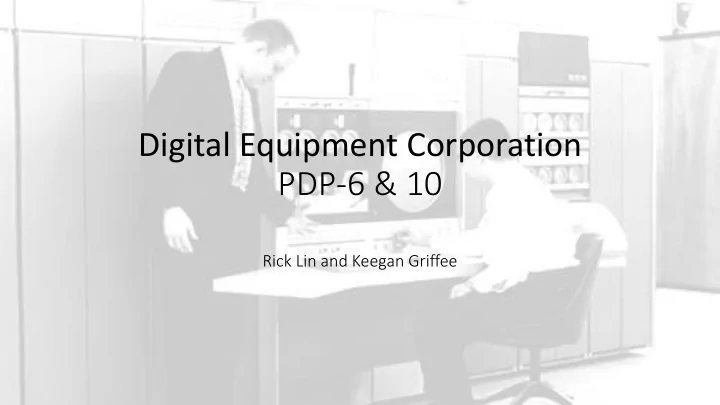

Digital Equipment Corporation PDP-6 & 10 Rick Lin and Keegan Griffee
PDP-6 (1963-1966) • Hardware Architecture • 36-bit words • 18-bit addressing, 256k word memory • Magnetic-core Memory • ISA • Very symmetrical • One-and-a-half address • Every instruction consists of a: • 9-bit opcode • 4-bit register code • 23-bit effective address field • 1-bit indirect bit • 4-bit register code • 18-bit offset
PDP-6 • Achievements • Supported time sharing • Status bit selecting between two operating modes • Supervisor and User modes • Could handle 20 - 30 users (with a single disk drive) • TOPS-10 Operating System • Introduction of virtual memory • Problems • Prone to failure • Large ‘6205’ boards would often break • Mechanical couplings • Powering related failures from powering on/off
PDP-6 Success? • Complex and expensive • Difficult to install • Difficult to operate • Targeted technical users in academia • 23 total sold • Cla Claim imed th this is was as th the end of f th their ir 36-bit it machin ines
PDP-10 (1966 – 1980s) • Hardware Architecture • 36-bit words • 18-bit addressing • 16xGeneral-purpose 36-bit registers • 3 major processors • KA10 – Flip chip transistors • KI10 – TTL SSI (Small Scale Integrated Circuit) • KL10 – ECL (Emitter Coupled Logic) • ISA • Almost same as the PDP-6 • Used byte instructions
Time Sharing Architecture • OS: TOPS-10 (later TOPS-20) • Virtual Memory • Supervisor mode • Instruction addresses correspond directly to physical memory • Access I/O operations via Unimplemented User Operations (UUO’s) • User mode • Addresses are translated to physical memory
PDP-10 Influences • Birth of Open Source Development • Assembled different components from non-DEC developers • Birth of variety of operating systems used • ITS (Incompatible Time Sharing by MIT) • CompuServe data centers • Paul Allen and Bill Gates to design Altair BASIC
References • https://en.wikipedia.org/wiki/PDP-6 • https://en.wikipedia.org/wiki/PDP-10 • http://gordonbell.azurewebsites.net/computer_engineering/00000511.htm • http://pdp10.nocrew.org/docs/instruction-set/pdp-10.html • http://pdp10.nocrew.org/cpu/processors.html Picture source • https://en.wikipedia.org/wiki/PDP-6#/media/File:Dec_pdp-6.lg.jpg • http://gordonbell.azurewebsites.net/computer_engineering/00000518.htm • http://www.columbia.edu/cu/computinghistory/pdp10.html • http://imgur.com/gallery/EaYMabg
Recommend
More recommend